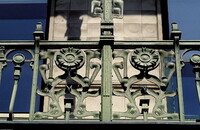| dc.coverage.spatial | Site: Vienna, Wien, Austria | en_US |
| dc.coverage.temporal | 1898 (creation) | en_US |
| dc.creator | Wagner, Otto | en_US |
| dc.date | 1898 | en_US |
| dc.date.accessioned | 2013-03-14T19:56:58Z | |
| dc.date.available | 2013-03-14T19:56:58Z | |
| dc.date.issued | 1898 | en_US |
| dc.identifier | 200250 | en_US |
| dc.identifier.other | archrefid: 1254 | en_US |
| dc.identifier.uri | http://hdl.handle.net/1721.3/108046 | |
| dc.description | Wrought iron work, balcony railing; In 1898 he also produced a scheme for the conversion and extension of Semper's Hofburg and two more residential blocks at Linke Wienzeile 38-40, including the Majolika Haus; the form of this crisp, flat, six-storey urban façade, with its positive cornice and iron balconies to the lower two storeys, is reminiscent of Schinkel's work: Wagner covered the façade in faience with flat, flowing patterns in pinks, blues and greens--only the ten lions' heads immediately below cornice level are in relief. Wagner joined the Secession the following year to the dismay of the establishment, which branded him an enemy of the official culture. Source: Grove Art Online; http://www.groveart.com/ (accessed 1/26/2008) | en_US |
| dc.format.medium | wrought iron; faience tile | en_US |
| dc.rights | © Scott Gilchrist, Archivision, Inc. | en_US |
| dc.subject | architectural exteriors | en_US |
| dc.subject | Secession Movement | en_US |
| dc.subject | Sezessionstil | en_US |
| dc.subject | Art Nouveau | en_US |
| dc.title | Majolika Haus | en_US |
| dc.title.alternative | Linke Wienzeile No. 40 | en_US |
| dc.title.alternative | Apartment Building, 40 Linke Wienzeile | en_US |
| dc.type | image | en_US |
| dc.rights.access | Licensed for educational and research use by the MIT community only | en_US |
| dc.identifier.vendorcode | 1A1-WO-WA-B5 | en_US |
| vra.culturalContext | Austrian | en_US |
| vra.technique | construction (assembling) fabrication attributes: ceramics | en_US |
| vra.worktype | apartment house | en_US |
| dc.contributor.display | Otto Wagner (Austrian architect, 1841-1918) | en_US |


